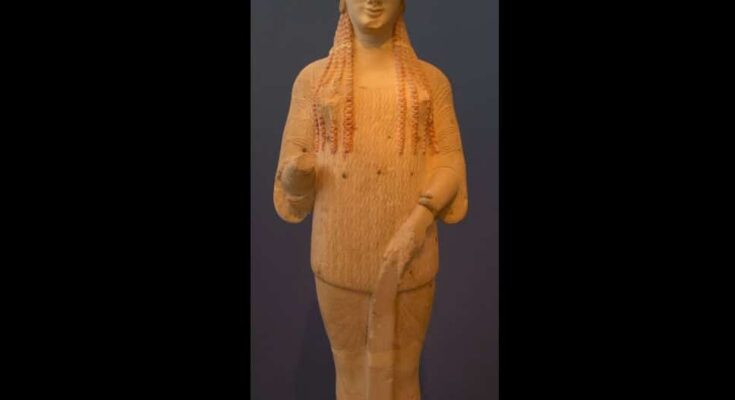Among the Kore statues displayed at the Acropolis Museum one in particular stands out for its beauty: Kore number 670, a gift to the goddess Athena, daughter of Zeus.
Kore (Korai in plural, meaning daughters in Greek) were freestanding sculptures of young women created during the Archaic period in Ancient Greece (approximately 660 to 500 BC). They are the female counterparts of the male Kouros statues.
These statues were typically made of marble and often depicted the young women clothed in elaborate garments, such as the peplos. They were characterized by a serene and idealized beauty, with a distinctive archaic smile.

What is so special about the Acropolis Kore 670?
Kore 670 was discovered in 1886 in the so-called “Korai Pit” northwest of the Erechtheion on the Acropolis.
The Kore with the slanting eyes and the intense smile is not one of the most characteristic Korai found on the Acropolis.
The Acropolis Museum says that unlike the rest of the Korai she is dressed in only a chiton tightened around the waist with a belt that forms rich folds and flows to her legs. The chiton has long sleeves that are secured with seven buttons rendered in relief and is decorated with painted rosettes.
The Kore with her left hand pulls aside her chiton’s central fold which is decorated with light-coloured meanders on a dark blue background, today lost. The same blue color was used in bands around the neckline and the diagonal folds near the chiton’s hem.

In her right hand, which was sculpted from a separate piece of marble, the Kore would have held her offering to the goddess. Her hair falls on her back in soft waves and four long, curled locks frame each side of her face and spill to the front.
The red color still visible today probably constituted the undercoat over which the final brown hue was applied.
On her head, she wears a crown with painted palmette spirals and lotus flowers, while added metal ornaments, perhaps lotus buds, would have been secured in the holes drilled on the upper surface of the crown.
Her ears are adorned with circular earrings decorated with rosettes and her left wrist covers a bracelet in the form of a snake rendered in relief. Traces of red colour can be seen on her lips and irises while black paint was used to accentuate the contour of her eyes.
This Kore is considered one of the most important and beautiful of the sculptures from the Acropolis appreciated for its fine detail and preservation.
In many places, the statue retains remnants of its once colorfully painted figure, which have largely been worn away by time and the elements. This sculpture offers visitors a portal into the history and beauty of ancient Greek art, the tumultuous history of the Acropolis and the birthplace of democracy, and an incredible story of discovery.
Related: Ten of the Acropolis Museum’s Most Beautiful Exhibits



